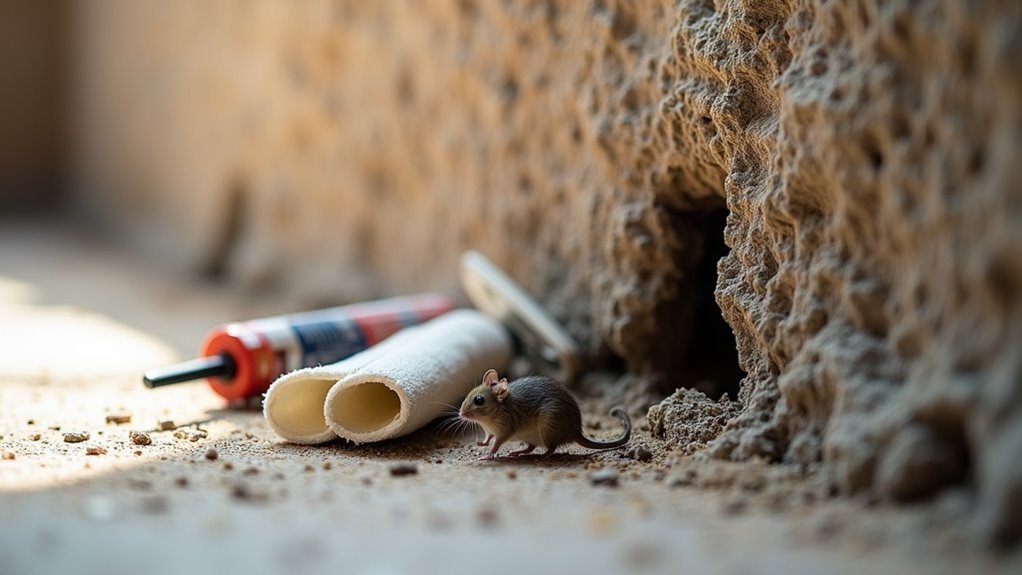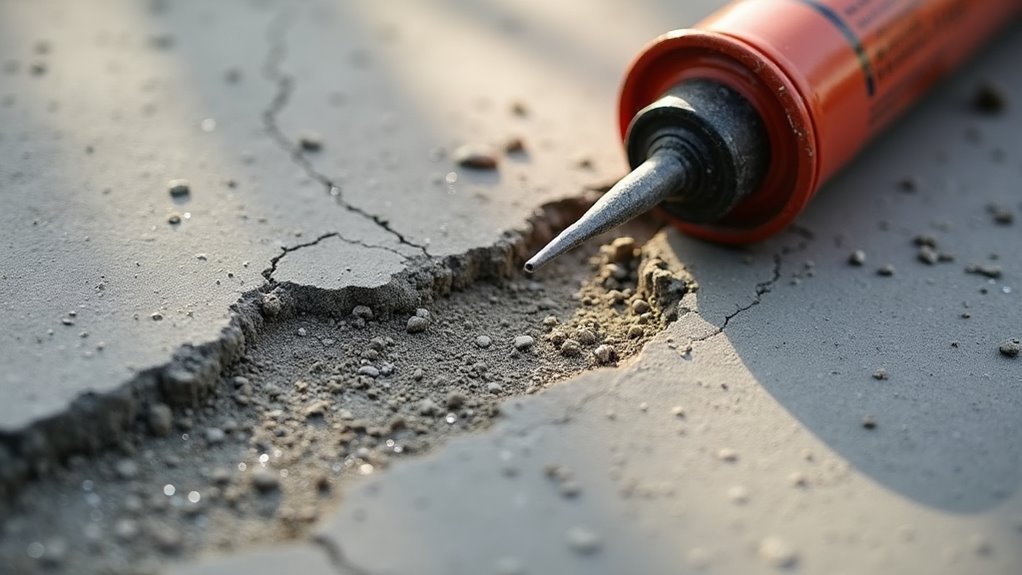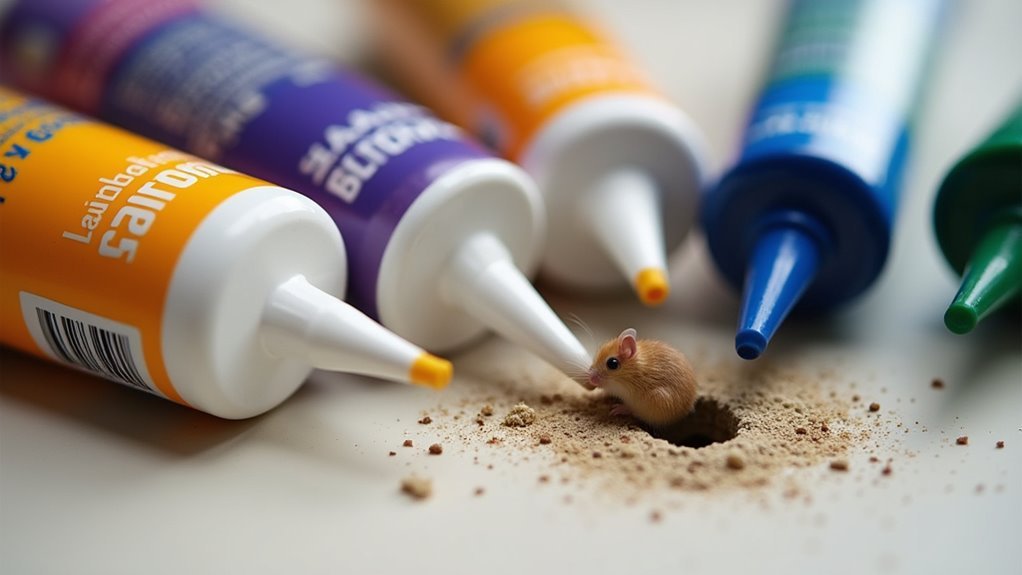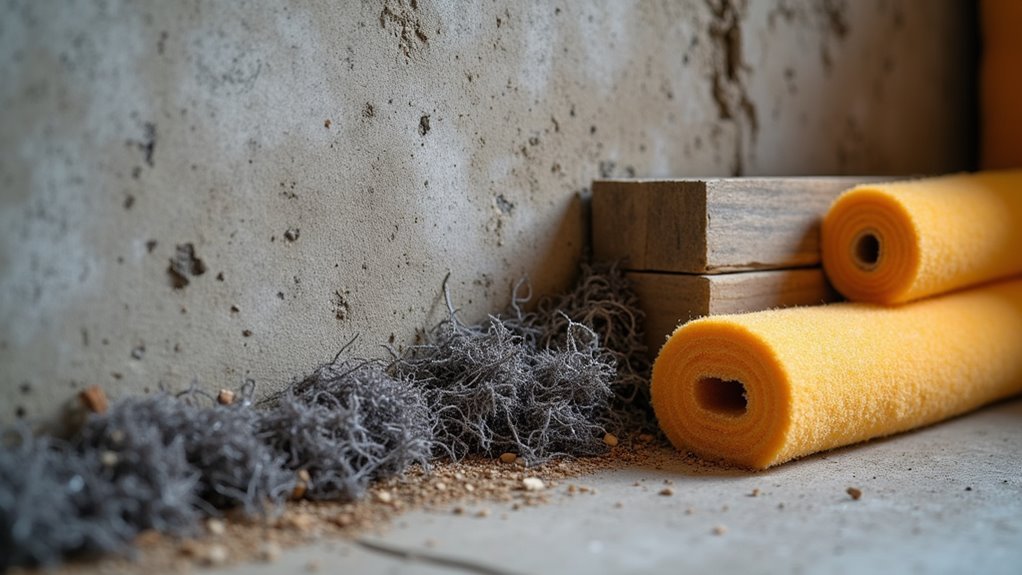You’ll need steel wool, concrete patching compound, and weatherproof caulk to effectively seal foundation gaps against mice. Fine-grade steel wool creates an impenetrable barrier that mice can’t chew through, while concrete patch handles larger cracks over 1/4 inch. Use silicone caulk for superior moisture resistance outdoors, or latex caulk for indoor applications. For irregular openings, spray foam expands to fill gaps completely. Proper application techniques and regular maintenance guarantee your foundation remains rodent-proof for years to come.
Why Mice Target Foundation Gaps for Home Entry

When mice scout for entry points into your home, foundation gaps become their preferred highways indoors. These persistent rodents can squeeze through openings as small as 1/4 inch, making even tiny foundation cracks vulnerable access points.
Once inside, mice quickly establish nesting sites in your basement or wall cavities, taking advantage of the direct interior access these gaps provide.
Foundation gaps give mice instant access to prime real estate in your basement and walls for permanent nesting sites.
Foundation gaps offer mice exactly what they’re seeking: warmth and shelter, especially during colder months. Environmental factors like building settlement and erosion worsen these openings over time, creating larger entry points.
Previous infestations leave pheromone trails that attract new mice to unsealed gaps, creating recurring problems. Without proper sealing materials to block these foundation vulnerabilities, you’re practically providing mice with an open invitation into your home.
Steel Wool: The Primary Defense Against Rodent Chewing
Steel wool stands as your most reliable weapon against mice that attempt to chew through foundation seals. Its tightly packed fibers create an impenetrable barrier that discourages rodent entry effectively.
When sealing gaps around your foundation, choose fine-grade steel wool for maximum density and protection. You’ll find steel wool withstands moisture and temperature changes remarkably well, making it ideal for long-term use.
However, don’t rely on steel wool alone to seal your house. Combine it with caulk or spray foam to block even the smallest gaps completely. This dual approach guarantees thorough coverage.
These preventive measures require regular maintenance since moisture exposure can cause rusting over time. Inspect your steel wool barriers periodically and replace any deteriorated sections to maintain ideal protection against unwanted rodent intrusion.
Concrete Patch Solutions for Large Foundation Cracks

When you discover large foundation cracks that exceed what steel wool can handle, you’ll need concrete patch solutions for permanent repairs.
You must first identify which cracks require patching by examining their width, depth, and structural impact before selecting the right application method.
The patching process involves specific techniques for surface preparation, material application, and proper curing to guarantee your repairs withstand time and prevent future rodent entry.
Identifying Large Foundation Cracks
Large foundation cracks exceeding 1/4 inch in width create highways for mice to enter your home and require immediate attention with concrete patch solutions.
You’ll need to carefully examine your foundation’s perimeter to identify these problematic gaps that serve as entry points for rodents. Look for cracks that appear wider than a pencil’s thickness, as these provide sufficient space for mice to squeeze through.
Pay special attention to areas where different materials meet, corners, and sections exposed to environmental factors like freeze-thaw cycles. During your inspections, use proper lighting and get close to the foundation surface to spot hairline cracks that may widen over time.
Mark identified foundation cracks for sealing to prevent infestations before they start.
Concrete Patching Application Methods
After spotting those problematic cracks, you’ll want to tackle them with the right concrete patching techniques to create an impenetrable barrier against mice. Concrete patching compounds offer the most reliable solution to seal foundation gaps permanently.
- Clean and dampen the area – Proper surface preparation guarantees your patch bonds correctly and won’t fail over time.
- Fill the crack completely – Use a trowel to apply concrete patch, eliminating every void that rodents could exploit.
- Smooth the surface – Level the patch to prevent weak spots where mice might break through.
- Respect curing time – Allow 24-48 hours for peak strength before considering the job complete.
- Schedule regular inspections – Monitor patched areas to identify new cracks before they become entry points that deter rodents effectively.
Curing and Durability Factors
While concrete patches create an effective barrier against mice, their long-term success depends heavily on proper curing conditions and material selection.
You’ll need to allow 24 to 48 hours curing time for the patch to gain strength and resist environmental factors. Choose a high-quality concrete patching compound that won’t fail when exposed to moisture and temperature fluctuations.
Proper adhesion requires clean surfaces and bonding agents before application.
Your durable barrier will only remain effective if you conduct regular inspections of patched areas. Foundation shifts can create new cracks over time, compromising your rodent-proofing efforts.
When you spot fresh gaps or deteriorating patches, address them immediately to maintain your home’s protection against mice infiltration.
Caulk Types and Applications for Small Foundation Gaps

When you’re sealing small foundation gaps against mice, you’ll need to choose between latex and silicone caulks based on your specific needs and environmental conditions.
Your application technique directly impacts the seal’s effectiveness, so proper surface preparation and caulk placement are essential for creating an impenetrable barrier.
The durability and weather resistance of your chosen caulk will determine how long your rodent protection lasts, making material selection as important as application method.
Latex Vs Silicone Caulks
The choice between latex and silicone caulk greatly impacts your foundation’s long-term protection against mice infiltration.
While latex caulk works well for indoor projects and offers easier cleanup, silicone caulk delivers superior performance for sealing small gaps around foundations.
When facing moisture resistance and temperature fluctuations, silicone maintains its integrity longer than latex alternatives.
Consider these key differences for foundation gaps:
- Durability: Silicone creates a more durable seal that withstands outdoor elements
- Flexibility: Silicone expands and contracts with temperature changes, preventing cracks
- Moisture protection: Silicone offers superior resistance to humidity and water exposure
- Maintenance: Silicone doesn’t require repainting or additional finishing touches
- Mice prevention: Both work effectively, but silicone provides longer-lasting protection
Proper Application Techniques
Success with foundation gap sealing depends heavily on following proper application techniques that maximize caulk performance.
Start by cleaning the area thoroughly and verifying it’s completely dry, as debris and moisture prevent proper adhesion. When filling gaps, apply caulk evenly to eliminate all voids—mice can squeeze through small openings as tiny as 1/4 inch. Use steady pressure to create a continuous bead that completely fills each gap without leaving air pockets.
Respect the manufacturer’s specified drying time, typically 24 hours, before exposing the area to moisture or stress. This patience guarantees an effective seal with ideal moisture resistance.
Schedule periodic inspections of sealed areas, as environmental factors can compromise your durable seal over time, requiring touch-ups to maintain protection.
Durability and Weather Resistance
Beyond proper application methods, your caulk selection considerably impacts how well your foundation seals withstand harsh weather conditions and the test of time.
Silicone caulk offers superior weather resistance and durability for outdoor foundation work, making it your most effective strategy for sealing gaps exposed to temperature fluctuations and moisture.
Polyurethane caulk provides exceptional flexibility for areas experiencing movement while maintaining strong adhesion.
Weather resistance considerations include:
- Temperature extremes – Silicone performs best in fluctuating conditions
- Moisture exposure – Choose silicone for wet environments, latex for dry areas
- UV degradation – Outdoor-rated formulas prevent breakdown from sunlight
- Freeze-thaw cycles – Flexible sealants accommodate expansion and contraction
- Maintenance schedules – Regular inspections guarantee continued effectiveness
Proper application of caulk with weather-appropriate materials creates lasting barriers against mice infiltration.
Metal Materials That Resist Mouse Gnawing
When mice encounter metal barriers during their attempts to infiltrate your foundation, they’ll quickly discover these materials present an insurmountable challenge to their persistent gnawing habits.
Steel wool proves exceptionally effective for sealing small gaps and mouse holes, but you’ll need to combine it with caulk to create a tight seal.
Steel wool combined with caulk creates an impenetrable seal that stops mice from infiltrating small foundation gaps and entry points.
Stainless steel mesh offers superior longevity, functioning as a durable barrier that withstands environmental elements while you prevent rodent entry.
For larger openings, metal flashing creates robust protection around your foundation’s perimeter.
These metal materials resist even the most determined gnawing attempts, but you must conduct regular inspections to identify potential corrosion or damage that could compromise their protective capabilities.
Spray Foam for Irregular Foundation Openings
Since irregular foundation openings present unique sealing challenges that standard materials can’t address effectively, spray foam becomes your most versatile solution for blocking mouse entry points.
The foam expands to fill irregular gaps completely, creating an airtight seal that prevents rodent entry while providing valuable insulation benefits.
Choose pest-control specific products for maximum effectiveness against mice. However, don’t rely solely on spray foam—use combination sealing with steel wool or caulk for thorough protection.
Essential spray foam considerations:
- Expands to fill odd-shaped voids standard materials miss
- Creates dual-purpose barrier blocking mice and improving energy efficiency
- Requires pest-specific formulation for best rodent deterrence
- Works best when combined with other sealing materials
- Needs regular inspections since environmental factors cause wear and tear over time
Proper Application Techniques for Maximum Effectiveness
Achieving maximum effectiveness requires proper preparation before applying any sealant to foundation gaps. Start by thoroughly cleaning around the opening to remove dust and debris, guaranteeing ideal adhesion for your chosen sealing materials.
Select appropriate sealants based on gap size—use caulk for small gaps and concrete patch for larger structural openings. Apply these materials evenly and completely, following manufacturer’s instructions for drying times to create an effective seal.
Your application techniques should eliminate all voids that mice could exploit. Choose weather-resistant options like silicone caulk over latex for better durability against moisture and temperature changes.
After installation, regularly inspect sealed areas for deterioration and reapply sealants when necessary. This maintenance approach guarantees long-term effectiveness and will prevent mice from finding new entry points through compromised seals.
Inspecting Foundation Entry Points Before Sealing
Before you seal any foundation gaps, you’ll need to conduct a systematic inspection to identify every potential entry point mice might exploit.
Since mice can squeeze through openings as small as 1/4 inch, you must inspect your foundation thoroughly for even tiny cracks and gaps.
Don’t underestimate how small an opening mice need – they can fit through gaps no bigger than a quarter’s width.
Focus your inspection on these critical areas:
- Utility line penetrations – Check where pipes, cables, and wires enter your home
- Material changes – Examine where siding meets concrete or other foundation materials
- Foundation corners – Look carefully at joints and connecting points
- Weep holes – Inspect unsealed openings in brick or masonry walls
- Seasonal vulnerabilities – Conduct inspections before colder months when new entry points may develop
Proper identification guarantees effective sealing and long-term protection.
Long-Term Maintenance of Foundation Seals
While sealing foundation gaps provides immediate protection against mice, maintaining those seals guarantees your defenses remain effective for years to come.
Conduct regular inspections and maintenance at least twice yearly to identify potential breaches in your foundation. During these inspections, monitor for signs of rodent activity like droppings or gnaw marks around sealed areas.
When you discover gaps and cracks or deteriorated seals, apply appropriate sealants immediately. Reapply sealants as needed, particularly in areas exposed to moisture or temperature fluctuations.
Choose weather-resistant materials such as silicone caulk or concrete patch for lasting durability. Keep detailed records of all maintenance activities to track effectiveness of sealants over time.
This systematic approach helps you prevent mouse infestation while ensuring your foundation remains properly sealed year-round.
Frequently Asked Questions
How Do You Seal Gaps to Keep Mice Away?
You’ll seal gaps using steel wool or copper mesh for pipes, silicone caulk for small cracks, expanding foam for larger holes, and weatherstripping around doors and windows to effectively block mice entry points.
What Sealant Can Mice Not Chew Through?
You can’t go wrong with steel wool, copper mesh, or silicone caulk since mice can’t chew through these materials. Concrete patch and mortar also work well for larger gaps that need permanent sealing.
What Is the Best Gap Filler for Rodents?
You’ll want steel wool for small gaps since rodents can’t chew through it easily. For larger openings, use concrete patch or expanding foam, depending on the size and location of the gap.
What to Put Under a Door Gap to Keep Mice Out?
You’ll want to install door sweeps or weatherstripping under your door gap. For larger openings, combine steel wool with caulk since mice can’t chew through steel wool and it blocks entry points effectively.
In Summary
You’ve got multiple material options to seal foundation gaps against mice. Steel wool works best for most openings since mice can’t chew through it. Use concrete patches for large cracks, appropriate caulks for small gaps, and spray foam for irregular spaces. Don’t forget metal materials like hardware cloth for added protection. Regular inspection and maintenance will keep your seals effective long-term, preventing future rodent entry issues.





Leave a Reply